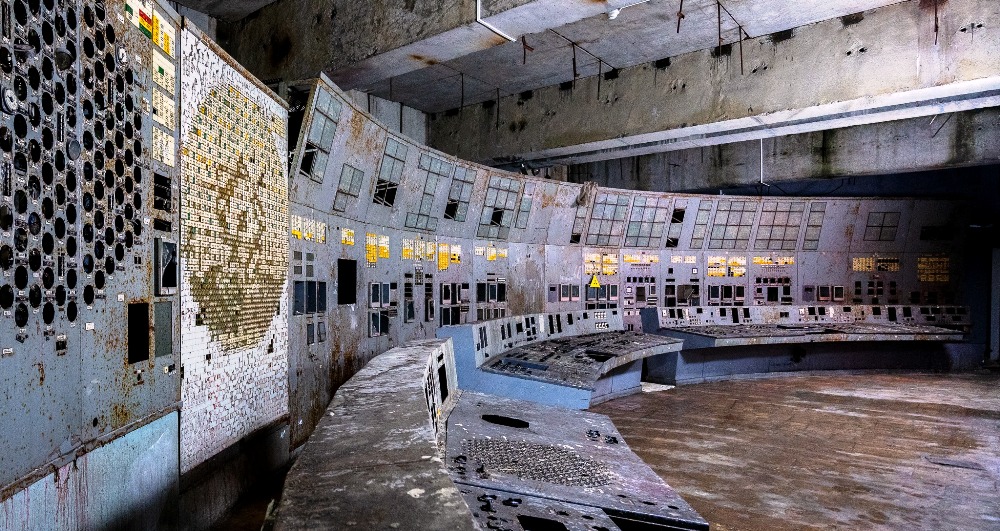by Sayeka Ghosh
The Chornobyl accident is one of the worst nuclear disasters in history, releasing 400 times more radioactive material than the Hiroshima atomic bomb.

On April 26, 1986, an explosion in one of the Chornobyl Nuclear Power Plant reactors (No 4) led to the beginning of what is known as the Chornobyl nuclear accident. This disaster is rated at seven on the International Nuclear Event Scale, which is of maximum severity, and is considered the worst nuclear accident in history.
What happened?
The construction of the Chornobyl power plant started in 1977 when Ukraine was still part of the USSR. Before the accident, the technicians at the Chornobyl Nuclear Power Plant in Ukraine were conducting a routine systems test on Reactor 4 to determine whether an emergency water cooling system functioned during a power outage. The test involved disabling emergency safety systems to simulate a power outage situation. However, the test was mishandled, causing an uncontrolled nuclear reaction that rapidly increased power output within the reactor core.
The operating procedures at Chornobyl did not permit reactor operation without the authorisation of the chief engineer. The intense heat caused fuel rods to fracture, channelling more power into surrounding fuel. Within seconds, pressure built up tremendously in the form of overheated steam. The steam blasted the 1000-tonne concrete and steel lid off the reactor, exposing the blazing nuclear core. This triggered two explosive forces that ripped the reactor apart and spewed burning chunks of radioactive material into the air.
Firefighters arrived but had no protective gear, putting them directly in extreme radiation zones as they fought the blazing ruins. Reactors No 3 and, No 1 and 2 were shut down the following day and the day after. Over the next nine days, multiple fires caused by the intense heat at the exposed core sent clouds of radioactive smoke billowing into the atmosphere. Radioactive particles and debris rained down in the nearby cities of Pripyat and Chornobyl.
The Soviet officials trying to cover up the accident led to more casualties in the neighbouring regions, even 1000 km away in Sweden. In a desperate effort to extinguish the fires and prevent further meltdown, helicopters dropped over 5000 tonnes of sand, lead, and boron onto the burning core. This finally contained the fire on 9 May. With the immediate crisis averted, authorities constructed a temporary concrete “sarcophagus” structure around the ruined reactor to temporarily contain the remaining radiation. However, the Chornobyl accident had already become one of the worst nuclear disasters in history, releasing 400 times more radioactive material than the Hiroshima atomic bomb. Vast areas of Ukraine, Belarus, and Russia were contaminated, forcing over 200,000 people to evacuate and resettle. The environmental and human impacts would reverberate for decades.
What caused the accident?
No single actor was solely responsible; multiple human errors and Soviet institutional failings across engineering, operation, and crisis response all compounded the Chornobyl tragedy. According to available literature, the Chornobyl accident was a product of a flawed Soviet reactor design, which was the result of the direct consequences of Cold War isolation and the lack of nuclear safety culture. Multiple actors played a role in this accident. The plant was operated by Soviet authorities, with the operators following flawed safety protocols that led to the initial reactor explosion. Poor reactor design, lack of operational safety culture, and a political climate of censorship were seen as primary reasons.
The Soviet government downplayed its severity in the early days. When the accident’s massive radiation release was detected in Sweden, the Soviet Union was finally compelled to admit the event. Delayed evacuation of nearby areas led to increased radiation exposure. The UN ultimately stepped in, assessing the nuclear fallout, providing humanitarian aid to affected populations in Ukraine, Belarus and Russia, and coordinating an international response over many years.
The Aftermath
First, the environmental and humanitarian catastrophe. The sheer magnitude and scale of the Chornobyl nuclear disaster translated into an environmental and humanitarian catastrophe. The miscommunication from Soviet authorities left local populations unaware of the accurate scale of the disaster and without guidance on protective measures. No established authority was able to immediately address critical safety questions like whether it was safe to remain indoors, consume water, or eat local produce. Promptly communicating protective steps could have enabled many to avoid exposure to dangerous radionuclides like iodine-131, which causes thyroid cancer.
In the immediate aftermath of the reactor explosion, massive amounts of radioactive materials were released over ten days, saturating the landscapes of Ukraine, Belarus, and Russia and even reaching Scandinavia and other parts of Europe with deadly radioactive contamination. Over 770 square miles around Chornobyl became an uninhabitable exclusion zone. In the aftermath, over 335,000 people from the area had to be evacuated and resettled, with the town of Pripyat entirely abandoned. The accident’s human toll was immense; 28 firefighters and operators were killed by acute radiation sickness within months.
Hundreds more suffered radiation burns and illness, with elevated cancer risks persisting for decades. Conservative estimates attribute around 6,000 cases of thyroid cancer to Chornobyl’s radioactive iodine fallout among those exposed as children. However, some projections suggest the ultimate death toll could potentially reach over 1 million from long-term radiation effects.
Second, there is a need for early action and global responses. Early evacuation would have been helpful to people during the peak release periods. For the first four years, the Soviet government primarily handled the Chornobyl aftermath at a national level without international assistance.
It was not until 1990 that Soviet authorities acknowledged needing international aid, leading to UN coordination and international cooperation efforts. The IAEA’s International Chornobyl Project stated in a 1991 technical report, “This (contamination of solid waste disposal) is probably the most significant, and most underreported, aspect of the consequences of the accident.”
Third, there are deep concerns over the safety of nuclear reactors worldwide. While the full scope wasn’t grasped initially, Chornobyl spurred major nuclear safety overhauls worldwide. International cooperation increased vastly, with over 1,000 Soviet engineers visiting Western plants and implementing upgraded safety protocols and equipment like automated shutdown systems. The Convention on Nuclear Safety was adopted in 1994 as another post-Chernobyl reform. While safety measures have been dramatically improved, the tragic legacy of Chornobyl persists to this day.
(Sayeka Ghosh is an undergraduate student at St Joseph’s University, Bengaluru, Department of International Relations, Peace and Public Policy.)















